|
The UK government recently announced that zero carbon homes 2016 and zero carbon buildings 2019 (non-domestic) will be abandoned. The zero carbon homes policy was designed so that all new buildings would generate as much energy from on-site renewables (PV, wind,…etc) as they consume to heat and power the building. It was a flagship environmental policy and was billed as the first country to ‘commit’ to carbon neutral buildings. Once more the quote “greenest government ever” comes to mind!
So what does this mean for the carbon footprint of the buildings sector? |
Energy consumption in the building sector is projected to double by 2050 and the carbon footprint is expected to increase by anywhere from 50-150% on this timeline. It is therefore unfortunate that this flagship policy has been abandoned.
A further implication is that the removal of 2016 zero carbon homes further extends the debate around refurbishment versus replacement. Furthermore, refurbishment was identified as a key carbon mitigation measure by the IPCC. A large amounts of embodied energy and embodied carbon is invested in a building structure and by retaining as much structure as possible the whole life carbon footprint of the building project is reduced.
Recent analysis by Circular Ecology suggested that with current building regulations it could take 34 years for the lower operational carbon of a new build house to payback the embodied carbon of building a new house. With the scrapping of 2016 zero carbon homes the question of refurbishment or replacement has never been more important.
A further implication is that the removal of 2016 zero carbon homes further extends the debate around refurbishment versus replacement. Furthermore, refurbishment was identified as a key carbon mitigation measure by the IPCC. A large amounts of embodied energy and embodied carbon is invested in a building structure and by retaining as much structure as possible the whole life carbon footprint of the building project is reduced.
Recent analysis by Circular Ecology suggested that with current building regulations it could take 34 years for the lower operational carbon of a new build house to payback the embodied carbon of building a new house. With the scrapping of 2016 zero carbon homes the question of refurbishment or replacement has never been more important.
Source: Circular Ecology News RSS



